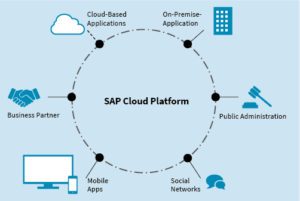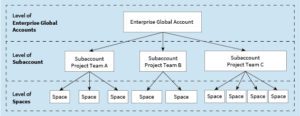This blogpost is one of a series of articles on the “Blockchain mit SAP” (Blockchain with SAP) book published in 2019 (Rheinwerk Verlag, Bonn, ISBN 978-3-8362-6914-8).
The SAP Cloud Platform is the basis for the SAP blockchain-as-a-service products discussed in the book. It offers various billing models and runtime environments. A good a time as any to take a closer look at the product range.
The SAP Cloud Platform is SAP’s cloud computing product and is one of the company’s future growth drivers. It aims to offer companies appropriate and attractive products that help them migrate their applications to the cloud.
The SAP Cloud Platform is thus a PaaS – Platform-as-a-Service – that can be used to create entire system landscapes within the cloud.
It offers a range of “runtime environments” – standardized virtual execution environments that contain defined services. Thanks to virtualization, these services can be easily launched, stopped, and monitored – and freely combined with other instances.
The keywords here are services and microservices – ones that can be combined to create larger gernapplications. Based on the concepts of a twelve-factor app, smaller services are combined into bigger solutions.
When it comes to application development, the SAP Cloud Platform also supports concepts like continuous integration and deployment.

Billing Models for the SAP Cloud Platform
The SAP Cloud Platform offers its users two different billing models:
The Use-Based Model
This billing model – also known as pay-as-you-go – makes it possible for you to calculate bills for the SAP Cloud Platform services used, down to the exact time and resources. Generally, longer and more intensive use results in higher cost.
The Subscription Model
The subscription is a flat-rate that allows unlimited use of the booked services within the booked timeframe. It is the cheaper option when it comes to longer and more intense use.
The Trial Account
For those who can’t or don’t want to decide yet, SAP also offers a trial account. This usually runs 30 days, but can be renewed twice to last up to 90 days. There are some restrictions on the account, though, for example it’s only possible to set up one developer node for Hyperledger Fabric.
Your Global Account
As a corporate customer, the typical SAP Cloud Platform purchase would be a Global Account that grants access to all paid resources. The idea is that this Global Account is taken care of by one or several sysadmins in your company. Several subaccounts are created from the Global Account with access to parts of the overall resources.
In addition, a Global Account contains a list of all employees who can be assigned to SAP Cloud Platform projects. This means that it corresponds to the company’s SAP Cloud Platform global membership list.
Subaccounts
Subaccounts are defined and generally linked to projects or tasks; resources and employees are assigned to them from the Global Account. Subaccounts are further split up unto Spaces, which are defined working environments for individual services or modules.
A Subaccount also has to be assigned a runtime or execution environment like Cloud Foundry or Neo. The execution environment defines the appropriate services provided in the Service Marketplace.
Spaces
Spaces contain individual services needed for operation of a larger application. As with Subaccounts, resources and employees can be assigned to the Spaces. A Space usually delivers a service. It can run a blockchain node instance or a Node.js server that hosts webpages or provide a REST API.

Navigation
The SAP Cloud Platform is navigated in logical levels:
- After logging in, the user goes from one or more Global Accounts to…
- a Subaccount, and from there…
- to a defined Space.
As simple as this sounds at first, each object actually has its own logical level, meaning that the navigation structure of the interface changes and that users have to understand the context in which they find themselves.
Service Marketplace
The Service Marketplace is the central hub for the services options provided in the SAP Cloud Platform. The services offered are adapted to the selected runtime environment of the currently selected Subaccount.

More articles of this series can be found here:
- Blockchain with SAP: What is Blockchain and How Does It Work?
- Blockchain with SAP: Blockchain-as-a-Service Products from the SAP Cloud Platform
- Blockchain with SAP: Business application scenarios for blockchains
- Blockchain with SAP: The First Steps to Having Your Own Blockchain
- Blockchain with SAP: Developing Applications with Hyperledger Fabric
- Blockchain with SAP: Developing Blockchain Applications with Hyperledger Fabric
- Blockchain with SAP: SAP HANA Integration
- Blockchain with SAP: MultiChain Applications
- Blockchain with SAP: MultiChain Applications
- Blockchain with SAP: Hybrid Network Architecture and Camelot Hypertrust Platform
- Blockchain with SAP: Summary and outlook
Do you want to learn more about the Hyperledger Fabric, MultiChain, or Quorum blockchain frameworks or about the possibilities of our flexible Camelot Hypertrust Platform? In our book “Blockchain mit SAP”, we detail the advantages of running these frameworks alongside the SAP Cloud Platform. A detailed extract from the bookis available on the publisher’s website.
